
DSL-G624T Wireless A DSL Router User’s Guide
SNMP
SNMP (Simple Network Management Protocol) is a widely used network monitoring and control protocol that reports
activity on each network device to the administrator of the network. SNMP can be used to monitor traffic and statistics of
the router. SNMP enables network management stations to read and modify the settings of gateways, routers, switches,
and other network devices. Use SNMP to configure system features for proper operation, performance monitoring, and
detection of potential problems in the Router or network. The DSL-G624T supports SNMP v1 and SNMP v2c.
SNMP Management window
Under SNMP Management, enable or disable SNMP Agent or SNMP Traps by using the check boxes. An SNMP
Agent is software that runs locally on the device. A defined set of variables (managed objects) is maintained by the
SNMP agent and used to manage the device. Traps are messages that alert network personnel of events that occur on the
Switch. The Router generates traps for these events and sends them to the trap recipient (or network manager). In the
Name, Location and Contact fields, enter the appropriate information of the Network Administrator. Under
Community, enter the name of an SNMP community string that defines the relationship between the SNMP manager
and an agent. The community string acts like a password to permit or deny access to an agent on the Router. The
defining characteristic associated with the community string is the Access Right. The agent’s access right can be set as
either read/write or read-only. Under Traps enter the Destination IP address and Trap Community Name so that the
agent will send traps to this management server. The Trap Version can also be set to either SNMP V1 (to specify that
SNMP version 1 will be used) or SNMPv2c, which supports both centralized and distributed network management
strategies. SNMP V2c includes improvements in the Structure of Management Information (SMI) and adds some
security features.
54


















